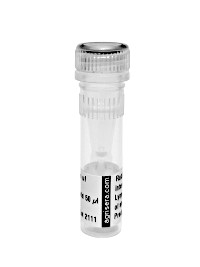1

Anti-VRN2 | Vernalization protein 2
AS08 341 | Clonality: Monoclonal | Host: Mouse | Reactivity: Triticum aestivum
- Product Info
-
Immunogen: KLH-conjugated synthetic peptide chosen from Triticum aestivum VRN2 sequence
Host: Mouse Clonality: Monoclonal Purity: Total IgG. Protein G purified purified from Cell culture supernatant. Format: Lyophilized Quantity: 50 µg Reconstitution: For reconstitution add 50 µl of sterile water Storage: Store lyophilized/reconstituted at -20°C; once reconstituted make aliquots to avoid repeated freeze-thaw cycles. Please remember to spin the tubes briefly prior to opening them to avoid any losses that might occur from material adhering to the cap or sides of the tube. Tested applications: ELISA (ELISA), Western blot (WB) Recommended dilution: 1 : 10 000 (ELISA), 1 : 1000 (WB) Expected | apparent MW: 23.7 kDa - Reactivity
-
Confirmed reactivity: Triticum aestivum Predicted reactivity: Triticum monococcum
Species of your interest not listed? Contact usNot reactive in: No confirmed exceptions from predicted reactivity are currently known - Additional Information
-
Additional information: VRN-2 and ZCCT2 full-length proteins were expressed as GST fusion proteins in E. coli and purified through GST sepharose columns. The purified VRN-2 and ZCCT2 proteins were used to test the specificity of the VRN-2 antibody by Western blot analysis. A Western blot experiment showed that the VRN-2 antibody was able to differentiate VRN-2 from the ZCCT2 protein.
Additional information (application): There is some non-specific binding in a western blot when using anti-TaVRN2 antibody on nuclear extracts of T, monococcum - Background
-
Background: Plants with a winter growth habit flower earlier when exposed for several weeks to cold temperatures, a process called vernalization. The wheat vernalization gene VRN-2 is a dominant repressor of flowering that is down-regulated by vernalization. Loss of function of VRN-2, whether by natural mutations or deletions, results in spring lines, which do not require vernalization to flower.
- Protocols
-
Agrisera Western Blot protocol and video tutorials
Protocols to work with plant and algal protein extracts
Oxygenic photosynthesis poster by prof. Govindjee and Dr. Shevela
Z-scheme of photosynthetic electron transport by prof. Govindjee and Dr. Björn and Dr. Shevela - Reviews:
-
This product doesn't have any reviews.


